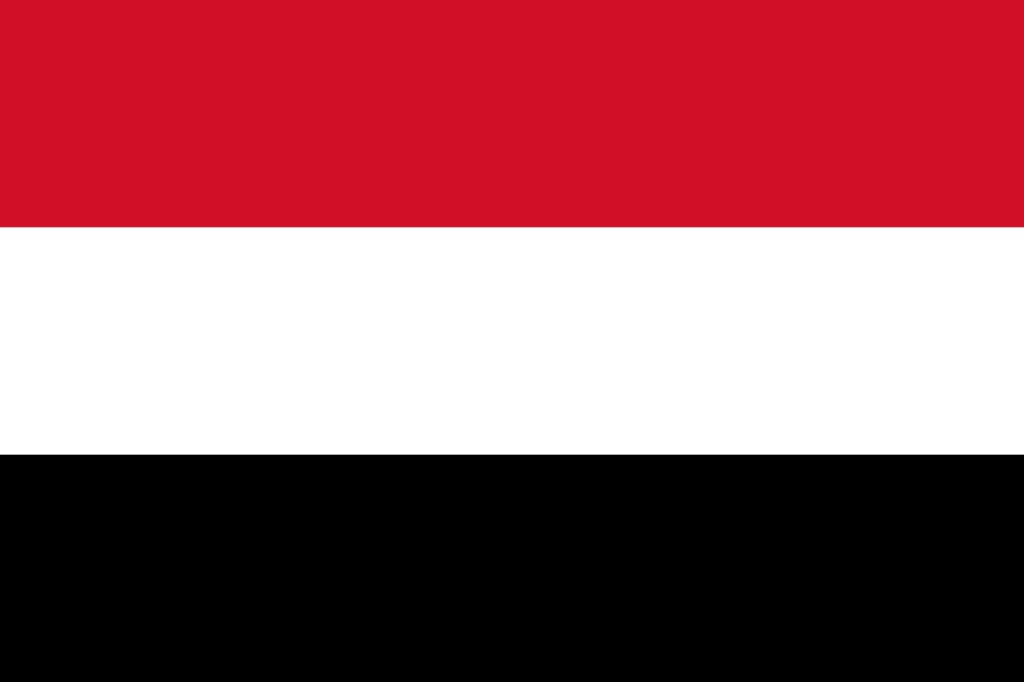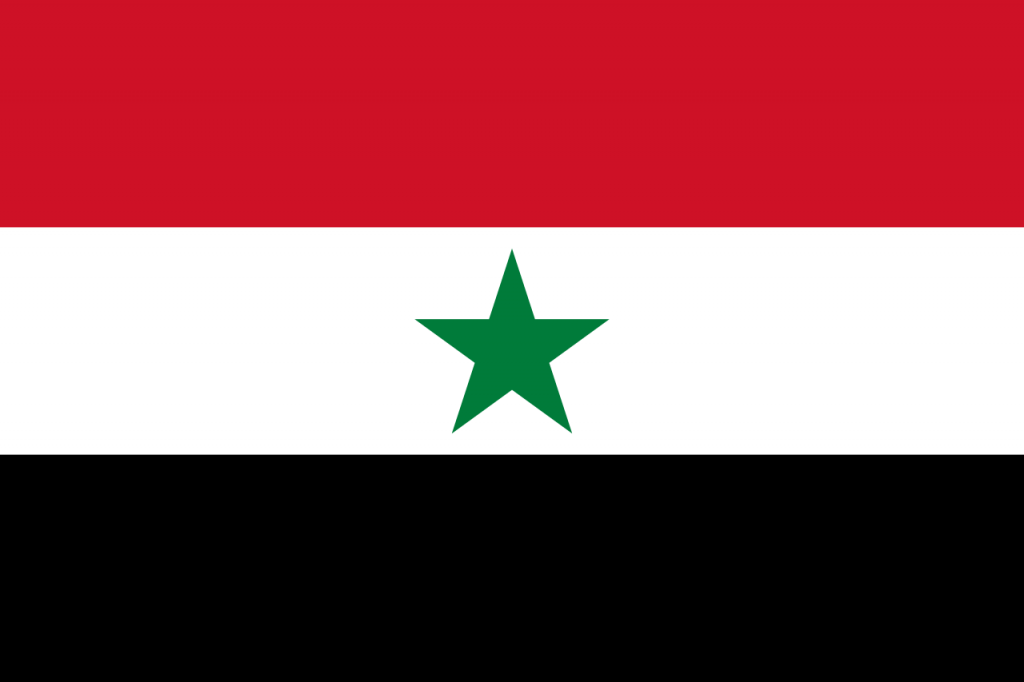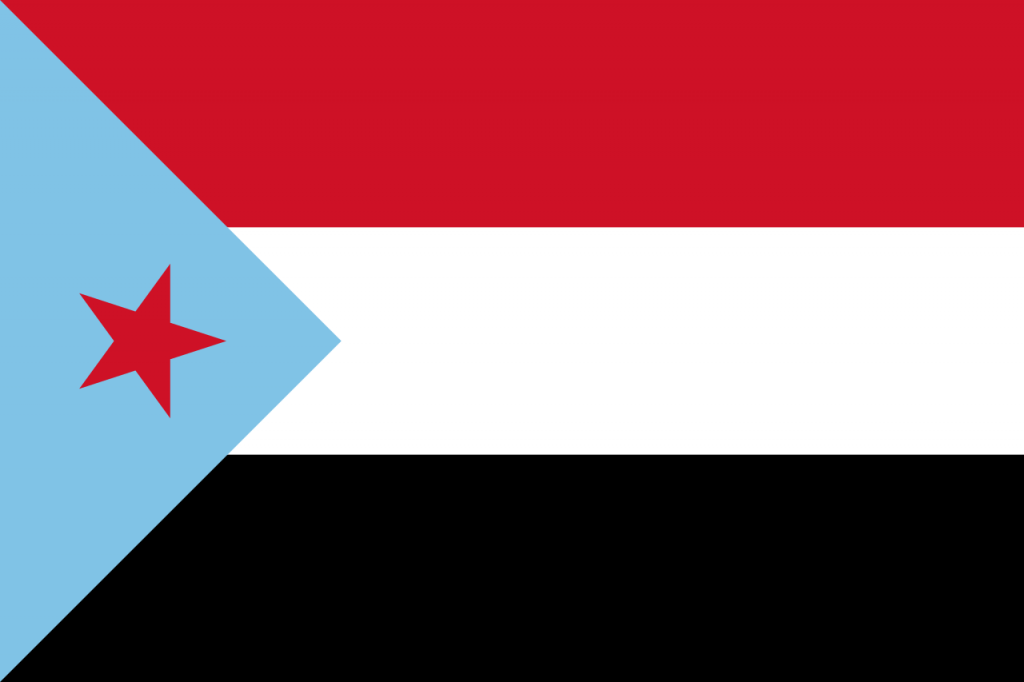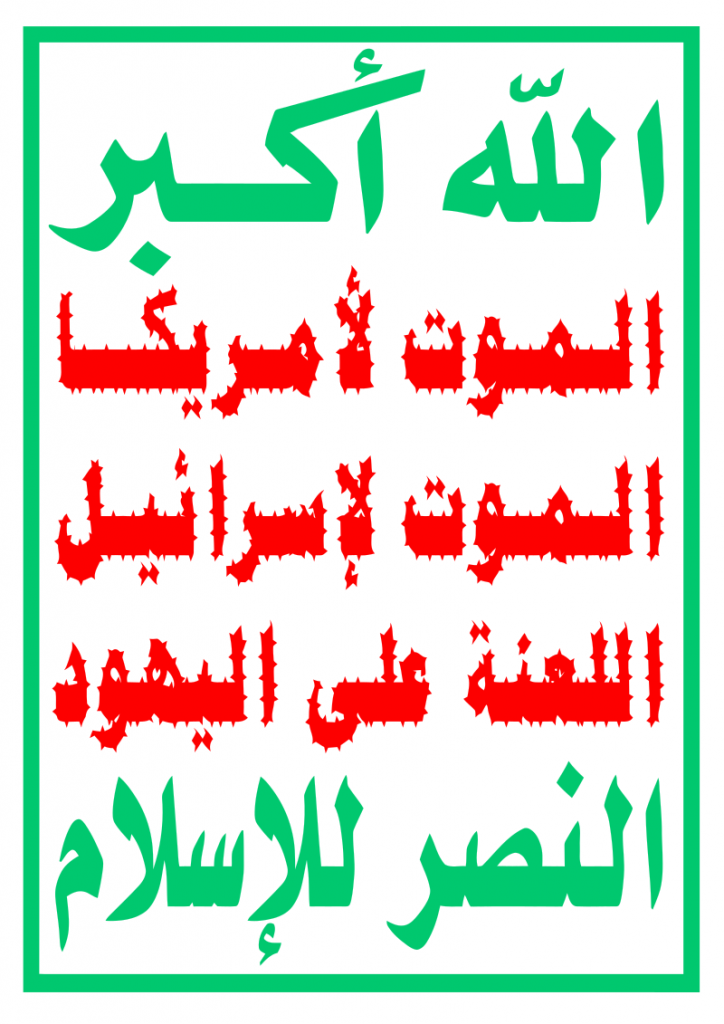The nation of Yemen has long been an outlier among the other nations of the Arabian peninsula, lacking the dazzling skyscrapers of Dubai and Riyadh, not to mention charting a completely different political path, free of the monarchies typical of the region. A path that has seen war engulf the nation for the last decade, with multiple factions and nations vying for influence. So what’s Yemen’s deal anyway? We might get some idea by looking at the flag of Yemen… Along with some of the other flags that have come and gone over the years.
Flag of Yemen

The current and internationally recognized flag of Yemen is this simple tricolour arrangement of red-white-black, like an inverted imperial German flag. Despite appearances, this has nothing at all to do with Germany, rather it takes its influence from the Arab liberation flag. As a matter of fact… It IS the Arab liberation flag, first flown during the Egyptian revolution under Gamal Abdel Nasser, expressing the hope for Arab unity and perhaps a united Arab nation. The influence of this flag can be seen throughout the region, with its colours appearing on the flags of Iraq, Syria, Sudan and of course, the flag of Yemen.
While those flags have tended to mix it up a little, such as with stars for the Ba’athist state of Syria, the Takbir in Iraq and eagle in Egypt, Yemen has chosen to keep its flag free of such iconography. The symbolism of the colours itself has been altered, as Egypt originally considered the colours to be specific to its own history. Yemen instead sees the red as symbolic as the blood shed by martyrs, the white symbolic of a bright future and the black as representing a dark past.
So why exactly is this the Yemeni flag in the first place? In the early 20th century, Yemen was a Gulf monarchy much like the other countries in the region. Unusually though, this monarchy tried to align itself with Nasser’s revolution in the 1950s, with the origin of their national flag coming from the United Arab States confederation, which saw Egypt, Syria and Yemen unite in 1958 under a flag that looks exactly like the current Syrian one, complete with the two green stars. This formation meant little in practicality, with the royalist flag still in use throughout the country and the effort being abandoned entirely in 1961.
The following year, the Yemeni king died and his son was crowned. That same year, Egyptian-trained military officers launched a coup to create the Yemen Arab Republic, beginning a civil war that dragged on until 1970, with pro-republic forces getting substantial support from Egypt. It’s no wonder then that they chose the earlier flag design as the new flag of Yemen when they emerged victorious. Or at least… Their flag of Yemen was pretty close to this one.
Flag of the Yemen Arab Republic

This flag style just can’t escape the green stars. While Syria has two and Iraq under Saddam had three, the Yemen Arab Republic from 1962-1990 had just one green star on the flag shared by all of them. At the time of its adoption, Iraq hadn’t yet taken up its flag and Syria had reverted from the previous United Arab Republic flag with two stars, which later became its Ba’athist flag. This left Yemen alone in upholding those aspirations, hence there being only one star.
The Yemen Arab Republic never adhered to Ba’athism like Iraq and Syria, rather it remained true more to Nasserism… At least it seemed that way for a time. While the initial leader of Yemen’s revolution, Abdullah al-Sallal, was very much pro-Nasser, he was overthrown in 1967 by Abdul Rahman al-Eryani, who instead opposed Nasser and sought reconciliation with the other gulf states like Saudi Arabia. Still, the flag remained. He too was toppled in 1974 by Ibrahim al-Hamdi who pivoted away from Saudi Arabia once more and oversaw a massive rise in living standards. He was assassinated in 1977. And his successor in 1978.
Eventually, Yemen came under the leadership of Ali Abdullah Saleh in 1978. By this point ideology was a non-factor in the Yemeni state and the flag of Yemen was almost incidental. Saleh established his family into key positions and kept himself secure through patronage from powerful tribes and neighbouring states like Saudi Arabia. The ambitious economic programs of al-Hamdi were scrapped, though modest growth continued, keeping the threat of civil war at bay. At last in 1990, the collapse of the Soviet Union facilitated the reunification of North and South Yemen… Oh yeah, did I forget to mention that part?
Flag of the People’s Democratic Republic of Yemen

That’s right, there were two Yemen’s! What I’ve been talking about so far has been North Yemen, centred around the capital of Sanaa in the heavily populated north-western chunk of the country. The rest, comprising most of its landmass but with much lower population density, was the only Marxist-Leninist state in the Arab world, the People’s Democratic Republic of Yemen. As you can see, they kept the basic framework for the flag of Yemen, but included a blue triangle with a red star, taken from the emblem of the Yemeni Socialist Party.
Back when Yemen had been under the rule of the British, south Yemen had been de-facto separated through the Aden Protectorate and was not under the same king that ruled north Yemen. This political situation allowed for an independent political movement to develop in the south, namely the National Liberation Front. While one faction in South Yemen was receiving support from Nasser, the NLF gradually became more Marxist in character, perhaps inspired by the fact that they were directly fighting against British colonial occupation.
In 1967, the NLF won the war and turned their guns on the Nasserists, who had been disempowered by Nasser’s failure in the Six Day War. While Marxist aligned, it wasn’t until 1969 that an even more radical movement within the NLF seized power through the ‘Corrective Move’, which ousted the moderate president and installed the Yemen Socialist Party as the sole ruling party. South Yemen became overtly Marxist-Leninist and established ties with the eastern bloc, implementing nationalisation, land reform and central planning.
As it turned out, this worked out rather well. By 1973, the economy bloomed by 25% and traditional Islamic customs were curtailed to grant equality between sexes, secular education, the abolition of polygamy and even Sharia law, in favour of a state legal code. The flag of Yemen in the south represented the only Marxist state in the Arab world. Alas, this made unification with the north a difficult task. In principle, both wanted it, but major challenges existed. Tensions occasionally gave way to fighting, followed by reconciliation and promises that never came to anything.
In 1986, a civil war broke out as a result of a power struggle within the ruling party, killing thousands and forcing tens of thousands to flee to the north. With the Soviet Union in slow collapse, its eventual fate was perhaps inevitable. Reforms in line with Soviet Perestroika began in the late 80s and negotiations for unification finally started to bear fruit. In 1990, with no Soviet backing left, North and South Yemen reunified and rather than simply adopting the northern flag of Yemen, the star was dropped and we have what we see today as the state flag of Yemen.
Though to this very day, there are many in south Yemen who fly the old socialist flag of Yemen. For some, this is nostalgia for the socialist past and a belief in the cause that state stood for, but for many more it is simply a desire for separatism in general. They feel that the north cannot represent the wishes and needs of the south, with the last decade of civil war only making that more clear to them. Today, the state flag of South Yemen continues to fly in regions of the south controlled by the Southern Transitional Council, a faction in the civil war that aligns with neither the Saudi-backed government or the Houthis. …The whothis?
Flag of the Houthis Movement

While not strictly a flag of Yemen, this flag should probably be acknowledged given their control of the whole north of the country. This banner is not the state flag of Yemen, in fact they fly the regular state tricolour much like their opposition, but it’s this banner of the Houthi movement that defines them as a whole separate movement. So first of all… That’s a lot of writing. What does it say? Well… “God is the Greatest; Death to America; Death to Israel; Cursed be the Jews; Victory to Islam.” …Well, they make their purpose pretty clear, don’t they?
While Houthis is the name most often applied to them, originating from the Houthi tribe that most of its leaders come from, the group calls itself Ansar Allah (Supporters of God). As you might guess, they’re primarily an Islamic movement, specifically representing the Zaidi Shia sect of Islam. They felt that the government ignored their struggles and marginalized their people, taking particular issue with the alliance with the USA and Saudi Arabia. Being Shia, it’s largely argued that the Houthis are aligned with Iran, though the extent of this is disputed.
The Houthis fought an insurgency throughout the early 2000s, where the government assisted by the Saudis tried and failed to crush them. By the time of the wider 2011 Yemeni revolution, Houthis were making major gains in a country gripped by turmoil and instability. In 2014, former president Saleh aligned with them against his former vice-president Abdrabbuh Mansur Hadi, winning over even more factions to the Houthis side. In 2015, they seized the presidential palace and took de-facto control over most of northern Yemen. Hadi escaped and began a Saudi-backed war in the south against them.
With traditional national leadership in Yemen largely discredited and fragmented, the Houthis became seen by many as the legitimate face of the uprising. When Saleh tried to defect to the pro-Saudi alliance in 2017, he was assassinated by them, further consolidating their power over northern Yemen. Since then, the Houthis have been embroiled in warfare against the Saudi-backed coalition, pulling in a wide array of support from Shia Islamists, Yemeni nationalists, leftists and others. Their ideology is often seen as incoherent, despite the clear messaging in their banner, they officially claim they only oppose the governments of the countries and people they seemingly wish death upon.
For now, there is one united flag of Yemen in a fragmented country between two completely opposed factions… And the flag of Yemen flown by the southern secessionists of course. Through all the myriad changes Yemen has gone through, with competing ideologies, territory and leaders, the red-white-black flag of Yemen clearly stands as a kind of unifying symbol through it all.
You can check out our Socotra Tours here.





